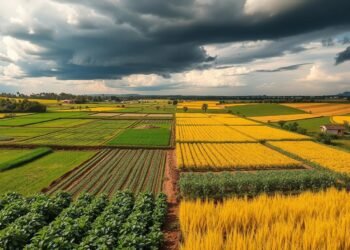Can growing food near where people live change how cities feed themselves and build stronger neighborhoods?
This practical approach brings cultivation, processing, and local distribution into dense areas. It boosts community resilience and supports local economies by cutting transport and linking growers with nearby customers.
City-based growing covers community gardens, rooftop farms, indoor farming, and small commercial farm plots in adjacent areas. These efforts plug into broader systems of production and processing so fresh options reach stores and markets faster.
More sources of information, technical help, and program support now help new and established growers plan and scale responsibly. Federal recognition and funding have expanded, making this model more viable for cities across the United States.
This guide frames next steps in soil safety, water access, funding pathways, market entry, and compliance — practical enablers for successful city farming that align food access with public health and equity.
Key Takeaways
- Growing food near consumers strengthens local economies and community resilience.
- City production links to processing and distribution systems for fresher access.
- Forms include gardens, rooftop and indoor farms, plus small commercial plots.
- Technical assistance and federal support are increasingly available.
- Sustainability benefits include shorter supply chains and lower emissions.
- Actionable steps cover soil safety, water, funding, markets, and compliance.
Service Overview: Sustainable Urban Farming Support for U.S. Cities
Many U.S. cities use targeted programs to help growers move from pilots into lasting operations. Our service package connects municipal teams, nonprofits, and farmers with practical support and clear pathways to scale.
We start by mapping current sites and gaps so leaders can prioritize investments that unlock safe, productive plots. Site assessments, soil testing facilitation, and risk mitigation guide early decisions and reduce long-term costs.
Our end-to-end advisory model covers strategy, design, and implementation. We link partners to grants, technical resources, and mentorship networks that speed project delivery.
To streamline funding and opportunities, we map eligibility, timelines, and application steps for federal, state, local, and philanthropic sources. We also plan equitable water access with cost analyses, infrastructure options, and SOPs that meet local policies.
Targeted training and cohort-based mentorship build capacity and market-readiness. We support data-driven pilots and supply practical toolkits so cities can replicate and scale programs aligned with community goals.
Urban agriculture in context: definitions, benefits, and resilient food systems
Producing food inside cities and their outskirts links growers, institutions, and residents in new supply models. This work spans many practices: growing, processing, distributing, and recycling within metropolitan spaces and nearby regions.
These efforts bring city agencies, community groups, farms, and small businesses together to steward land and resources. That collaboration supports local food production, builds jobs, and expands access to fresh, culturally relevant food.
Environmental gains include better soil stewardship, stormwater control, more green space, and lower transport emissions. Economically, local plots create neighborhood enterprises and new market routes for small producers.
At the community level, projects strengthen social ties, offer youth education, and preserve food traditions. Spreading production across many sites also makes food systems more resilient, reducing risks from supply shocks and emergencies.
Cities can start with a simple framework: assess local need, map stakeholders, prioritize safe sites, and plan for long-term sustainability across environmental, social, and economic goals.
Public programs and policy support for urban agriculture
Recent policy moves create focused federal support that connects growers, cities, and funders.

The Agriculture Improvement Act of 2018 created an Office of Urban Agriculture and Innovative Production at USDA. This office acts as a federal focal point for coordination, technical assistance, and strategic funding. It helps align grants, research, and outreach for city-based growers.
Advisory input and local policy pathways
An Advisory Committee brings practitioner voices into the rulemaking process. Their guidance helps local governments adopt practical food policy pathways and zoning updates.
Grant authority and pilot projects
The 2018 law also authorized USDA to fund innovative production and planning. Eligible activities include site planning, infrastructure, and market development.
Pilot projects for counties with many city or suburban plots test models that can scale. These pilots inform grant priorities and replication strategies.
Practical guides and alignment steps
Federal resources offer concise guides on funding, risk management, marketing, and on-farm innovation. Legal zoning guidance helps municipalities modernize ordinances for safe, neighborhood-compatible operations.
To be competitive for grants, align city plans with federal priorities, document public health and workforce benefits, and show clear metrics for local impact. This integrated approach strengthens public support and attracts cross-sector investment.
Soil health and water access: essential services for safe, productive urban farms
Healthy soil and reliable water are the backbone of safe, productive city growing sites.
Community-based soil health
Start with baseline soil testing to find contaminants common on previously developed land. Tests guide safe planting, remediation, and whether raised beds or clean fill are needed.
Local programs combine testing, organic amendments, and regenerative practices to rebuild fertility and lower exposure risks. Interpreting results leads to site-specific plans that protect public health and keep plots productive.
Equitable water access and technical support
Equitable water access means fair policies, cost-sharing, and infrastructure options like hydrants, metered hookups, or rain capture where allowed.
One-on-one technical support helps farmers through permitting, installation standards, and efficient irrigation practices for small areas. Ongoing monitoring of soil and water quality is key to responsible operations and clear risk communication with communities.
Site selection checklist
Balance access, visibility, tenure security, and environmental concerns. Coordinate with city departments to align policies and secure durable resources so sites remain viable for years.
Funding, markets, and capacity building for urban farmers
Local producers need clear funding paths and market links to turn small plots into reliable food sources. Strong financing and targeted programs help growers invest in infrastructure, tools, and consistent production.
Grants, funding opportunities, and capacity-building programs
Map relevant grants and funding to your project goals. Focus applications on infrastructure, equipment, and training that match program objectives.
Producer-focused guides connect growers with risk protection, marketing options, and innovation support.
Entering new markets and strengthening distribution systems
Routes into markets include CSAs, farm stands, restaurants, retailers, and institutions. Buyers expect consistency, safety, and basic documentation.
Use aggregation hubs and shared cold storage to cut last-mile costs and build steady distribution links.
Training, mentorship, and on-farm technical assistance
Combine capital with technical assistance to speed adoption of efficient systems and recordkeeping.
Mentorship models transfer practical skills in planning, season extension, and post-harvest handling.
Tip: Coordinate funding cycles, training windows, and market seasons to avoid gaps. Compliance and insurance matters should be part of onboarding with technical advisors to keep producers market-ready.
Policies, zoning, and compliance for city-based food production
Clear local rules make it easier for communities to grow food safely on underused land.
Modern zoning can explicitly permit agriculture on certain land types, speed approvals, and align planning with local food policy goals. Updating ordinances reduces confusion about where production is allowed and how it can operate in different areas.

Zoning approaches and common ordinance elements
Good ordinances list allowed uses, temporary structures, on-site sales, composting, and basic livestock rules. Clear language on setbacks, screening, and traffic helps sites fit neighborhood design.
Publish concise checklists so growers know permitting steps, inspection rules, and neighbor engagement expectations. That public information builds trust and speeds project starts.
Site selection, soil safety, and compliance
Use EPA’s “Know Before You Grow” guide to assess contamination risk, find contacts, and follow steps before planting. Integrate soil management plans and straightforward recordkeeping into compliance to protect public health and reassure neighbors.
Risk mitigation should include basic security like fencing, lighting, and community stewardship to limit vandalism and improve site security. Regularly update ordinances as new models and tech emerge, and keep legal and technical resources accessible for implementers.
Chicago case study: initiatives that strengthen community food systems
Chicago’s citywide nonprofit has combined policy work, education, and direct support into practical programs that improve food access and climate resilience.
Soil Health Program: Teams run baseline testing, map contamination, and deploy remediation or raised beds. They teach regenerative practices to rebuild long-term fertility and keep plots safe across diverse neighborhoods.
Water Access for Chicago Growers: Policy changes lower permitting hurdles while one-on-one technical help improves reliability and affordability. These steps make steady irrigation more attainable for small sites.
Farmer-to-Farmer Mentorship
Seasoned producers pair with new growers for hands-on learning. That peer-led training speeds adoption of best practices and strengthens local skills.
Capacity Building Grants
Small grants help a farm upgrade infrastructure, reach new buyers, and expand community programs. This funding boosts food security and market readiness.
Resources repository and mapping
A central repository lists policy updates, funding, jobs, animal care guidance, and training calendars. The Chicago mapping project visualizes active sites, aids coordination, and highlights service gaps for targeted investment.
Community-centered initiatives elevate neighborhood leadership and create a replicable model other cities can adapt to strengthen local food systems through integrated initiatives.
Urban agriculture
Small-scale production near neighborhoods shortens the route from field to table and builds local skills and civic pride.
Local food production and neighborhood distribution
Local production and neighborhood-scale distribution keep fresh food close to residents. Short routes cut spoilage and lower costs for buyers and sellers.
Neighborhood hubs and shared storage help producers meet demand for consistent supply and basic documentation.
People’s Gardens, school gardens, and mapping
People’s Gardens serve communities, not private yards, and can support food, habitat, education, or beautification.
School gardens teach hands-on skills and link youth to career pathways in growing and food systems.
Mapping active sites helps coordinate services, reveal service gaps, and guide investments for equitable reach.
Connecting programs, policy, and resources
Aligned policies connect growers to funding, safety guidance, marketing tools, and producer guides. That network turns pilots into durable operations.
How we guide scaling impact
We advise city leaders, nonprofits, and farmers to design scalable frameworks that integrate planning, compliance, and market access.
Historical examples and current projects inform practical models so institutions can replicate what works and expand cross-sector collaborations.
Conclusion
When municipalities align land use, funding, and technical assistance, neighborhood farms can deliver steady healthy food and jobs.
Clear policy, practical guides, and responsive programs make it easier for cities and farms to scale safe production. Site safety, soil care, and equitable water and infrastructure access are core parts of that work.
Local governments should use federal funding, update ordinances, and run pilots that validate models before wider rollout. Mentorship, training, and operational support help urban farming projects reach markets and grow reliably.
Coordinate programs across cities and communities to reduce barriers, boost economic participation, and expand long-term food security for residents.
FAQ
What does “urban and peri-urban food production” mean for cities and nearby communities?
It refers to growing food within city limits and in surrounding suburbs. This includes rooftop gardens, community plots, school gardens, and small commercial farms near cities. These sites shorten supply chains, increase local access to fresh produce, and create jobs while using vacant land and underused rooftops.
What are the main benefits of city-based food systems for residents?
City-based food systems boost local economies, improve access to healthy food, and foster community ties. They reduce transportation emissions, offer education and job training, and help address food insecurity by putting production closer to consumers.
How do programs build resilient food systems in metropolitan areas?
Resilience comes from diversifying production sites, strengthening local supply chains, and integrating storage and distribution hubs. Supportive policy, emergency plans, and farmer networks help ensure steady food supply during shocks like extreme weather or supply-chain disruptions.
What federal support exists for city-focused farming initiatives?
The USDA Office of Urban Agriculture and Innovative Production provides guidance and coordinates federal programs for city food projects. USDA grants under the 2018 Farm Bill and other competitive awards fund pilot projects, technical assistance, and infrastructure investments.
How can local governments work with federal programs to support growers?
Cities can align zoning, public land use, and food policy councils with federal grant priorities. They can apply for USDA funding, host pilot projects, and adopt ordinances that reduce barriers for small farms, farmers markets, and community gardens.
What grants and funding opportunities are available to small urban farms?
Growers can pursue USDA Specialty Crop grants, Community Food Projects, local foundation grants, and municipal incentive programs. Programs often fund training, equipment, site remediation, and market development—check USDA and state agriculture department listings for current contests.
How should community farms address contaminated soil and safety risks?
Follow EPA guidance such as “Know Before You Grow.” Test soil for lead and other contaminants, use raised beds with clean soil, install barriers, and implement phytoremediation or soil replacement when needed. Regular testing and clear communication with neighbors protect public health.
What water access solutions exist for city growers facing supply limits?
Municipal rebate programs, graywater systems (where allowed), rainwater harvesting, and negotiated access to city irrigation infrastructure can help. Advocacy for equitable water policy and one-on-one technical support programs also expand reliable access for small-scale farms.
How can growers enter new markets and scale distribution?
Start with farmers markets, CSA (community-supported agriculture) subscriptions, and partnerships with schools, hospitals, and local retailers. Invest in cold storage, shared processing facilities, and cooperative distribution to reach larger buyers and reduce per-unit costs.
What training and mentorship resources help new growers succeed?
Extension services, nonprofit incubator farms, farmer-to-farmer mentorship programs, and online courses provide hands-on training. Look for local land-grant university extension, Slow Food chapters, and USDA-supported technical assistance networks for tailored support.
How do zoning rules affect food production on vacant lots and rooftops?
Zoning determines allowed uses, structure height, and sales on-site. Cities may create special agricultural overlays, allow sales from market stands, and permit accessory structures for processing. Consult local planning departments to obtain permits and align activities with code.
What role does soil health play in long-term farm productivity in city settings?
Healthy soil improves yields, pest resistance, and water retention. Practices like composting, cover cropping, and crop rotation rebuild fertility and reduce input costs. Regular testing helps growers tailor amendments and monitor progress over time.
Can community gardens qualify for federal or local funding?
Yes. Many community gardens secure funding through municipal grants, community development block grants, nonprofit partners, and USDA community food project grants. Documentation of community benefit and clear project plans improve funding chances.
How do cities measure the impact of local food initiatives?
Cities track metrics like pounds of food produced, number of participants, jobs created, market sales, and reductions in food miles. Surveys on food access and health outcomes also show social impact. Data helps secure ongoing funding and policy support.
Where can I find site-specific soil testing and remediation help?
Contact your state university extension, local health department, or the EPA regional office for testing resources. Nonprofits like the Healthy Soils Program in Chicago offer testing, remediation guidance, and access to grant-funded support in some cities.
How do I connect with other growers and local food networks?
Join local farmer cooperatives, food policy councils, and online groups such as regional Facebook farming communities. Attend workshops, farmers markets, and city-hosted training events to build partnerships and exchange resources.
What are best practices for marketing produce from small city farms?
Emphasize freshness, transparency about growing practices, and local impact. Use social media, farmer market displays, CSA communication, and partnerships with chefs or grocers. Clear labeling and storytelling build trust and repeat customers.
How can municipalities make it easier for residents to start farming projects?
Simplify permitting, offer land leases on vacant city property, create small-business start-up grants, and provide shared infrastructure like tool libraries and storage. Policy changes that reduce fees and provide technical assistance increase participation.
What pilot programs under recent farm bills support city-based farming experiments?
The 2018 Farm Bill and subsequent USDA initiatives funded pilot projects for innovative production, including research on controlled-environment farming, integrated pest management, and community food systems. Check USDA announcements for new pilot solicitations.





